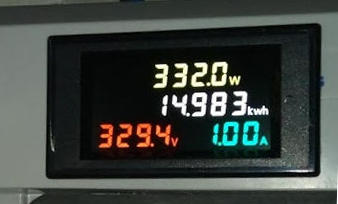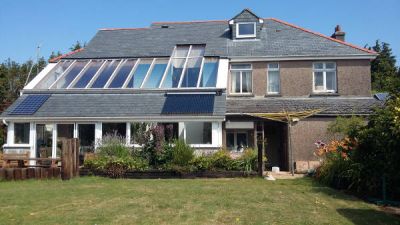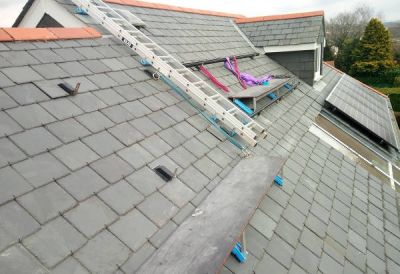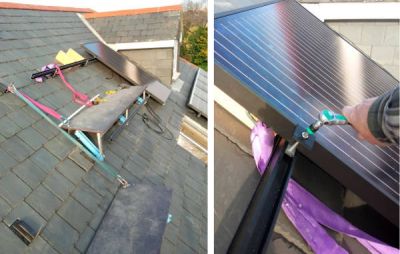Posted by: @transparentHowever, the Puredrive battery is 59Kg, and therefore just above the H&S guidelines for a "2-man lift".
It was quite hilarious watching the rig a pulley to get it into the loft!
Posted by: @transparentYour Dura-i-6k PV inverter has two solar MPPT inputs, with a maximum 550v DC rating for each.
The 2 MPTTs are in use. 1 is used for the east/north east 5 panels and the other is used for the 10 panels facing southwest.
Also just realised is a Solis S5-EH1P6K-L inverter
Posted by: @transparentIt's a single-phase grid-tied inverter, which begs the question of how it satisfies the usual G98 specification for max possible grid export of 3.6kW.
Or perhaps your DNO has granted a higher rate of export?
That's a good point. The MCS installer handled the DNO so will check with him
Posted by: @netdonkeyIt was quite hilarious watching the rig a pulley to get it into the loft!
Will the installer be laughing when you tell him that the new PAS63100 Standard states that domestic storage batteries shouldn't be within the habitable dwelling, and most certainly mustn't be installed in a loft?
Has he fitted a fire/smoke sensor, mains-operated and interlinked to others in the rooms below?
Let me point out that PAS-63100 isn't yet mandatory...
... but as soon as there's the first fatality, every insurance company will be insisting on it.
So it makes no sense to have a brand new installation which doesn't comply.
Save energy... recycle electrons!
I wasn’t aware of the new legislation coming in but will keep that in mind. I assume there is provision for existing installations? There is an area outside we could move the batteries to with an extra bit of cabling
They have linked up smoke/fire detectors to the existing system
@transparent Would installation in a conservatory be acceptable?
Daikin 6Kw ASHP.
MG4 EV
1926 Semi with loft and wall cavity insulation, all radiator.
Posted by: @netdonkeyI assume there is provision for existing installations?
Yes. Not only is PAS63100 not mandatory at this stage, but existing installations are exempt.
Even so, the Standard has been a year in development by EREC before being published by DESNZ.
I found out about it through newsletters sent to registered Electrical Contractors.
So that raises two questions:
- how did an MCS-approved installer not know about it?
- does your installation count as pre-existing if it was done after the Standard was formally published?
Those probably aren't the main issues however.
You are more likely to have difficulty if house-insurers stated insisting on PAS63100 compliance, rather than because Government decided to make it legally enforceable.
Save energy... recycle electrons!
@transparent I will be asking the same question about why it was situated in the loft rather than outside. Will let you know what they say.
Posted by: @jancoldWould installation in a conservatory be acceptable?
I don't think there's a clear answer to that.
It depends...
And that's one of the problems with the PAS63100.
It's trying to stipulate how an installation must be done, but without providing the background reasoning.
1: PAS63100 starts from a position in which it places all lithium-based batteries in one classification.
But there are half-a-dozen chemistry strategies used in mainstream lithium cells.
Failing to provide guidance for the different types of lithium cells, detracts from PAS63100 being trusted as definitive source of 'good practice'.
When attempting to install products, the guidance needs to be properly based on the underlying science.
2: The Lithium chemistry which needs to be treated with great care is LiMNC (Lithium Manganese Nickel Cobalt).
These have a high energy density.
Or to put it the other way around, for a given capacity, LiMNC is the lightest option.
That means it gets used in high-power devices where weight would be a problem:
- electric vehicles
- hand-held power tools (drills etc)
- electric bikes and skateboards
When over-charged or physically damaged, LiMNC self-combusts.
The chemical reaction produces enough oxygen to sustain the fire.
That makes it almost impossible to put out!
You are unlikely to encounter LiMNC cells within domestic storage batteries.
Home-based storage isn't required to be portable, doesn't need to accelerate fast, and the weight isn't a critical factor.
3: Most Storage Batteries are built from LiFePO4 cells (Lithium ferrous phosphate).
This chemistry is inherently stable.
If you drill right through one LiFePO4 cell in a working battery, you'd see some sparks due to short-circuiting the internal plates.
The cell will get hot, and will cease to work (forever!).
But it's pretty unlikely that it would cause a fire or damage other cells within the battery.
Most home-based storage batteries are enclosed, typically in a steel box.
Any heat will be contained within that box, which also provides a barrier to oxygen flow too.
Personally I don't build my LiFePO4 batteries into a container.
They simply sit on a strong shelf, made of heat-resistant material.
I prefer the terminals to sticking out horizontally.
If I drop a metallic tool, then it's not going to fall across those terminals.
It will continue falling towards the floor.
4: PAS63100 states the preferred location for lithium-based batteries is outside the house.
However, in the UK that subjects them to a temperature range which is likely to be outside the manufacturers' recommended envelope.
In particular LiFePO4 cells shouldn't be charged below 0°C (although discharge below freezing won't damage them).
Hopefully the battery manufacturer will have fitted temperature sensors.
The inbuilt Battery Management System (BMS) will isolate the battery to protect it...
... which probably then prevents you using the stored charge too!
So I disagree with PAS63100 in the best location for LiFePO4 batteries.
I think they should be within an unheated, but insulated room, such as an old larder/pantry or garage.
Whether a conservatory would be suitable depends on its temperature range.
In my experience, conservatories are designed for maximum solar gain, and are therefore too hot.
Overall, the best idea is to first learn a bit more about what type of battery you've got,
and then apply common sense.
Save energy... recycle electrons!
@transparent Thank you. My aim is firstly to heat my house with an efficiently set up heat pump then, later on, utilising the facility of charging at low cost periods and using that to cover the peak periods. I need to decide whether to be grid tied or stand alone. I am not sure about solar as with a conservatory running the whole width of the house scaffolding would be needed for any repair or maintenance and that is very expensive, that combined with tree shading makes it uneconomic.
I am an enthusiastic amateur regarding lithium my first source of information was the Battery University. I installed a Victron 90Ah lifepo4 battery, solar charged, in my boat 7 years ago solely to run the fridge and radio. This year I upgraded it to a 200Ah to run all services except the engine start. I had to decommission a rutland windcharger as it was going through a set of bearings every year and also had also damaged the coils somehow and was not worth repairing this season as the solar works just fine.
I have also made up 12v batteries from old 18650 cells, partly to get an electric drill out of a skip working and to learn more about how these things work, especially with regard to charging and balancing. None of these have self ignited so I must be doing something right!
In my work I as a kitchen Installer I had part p and gas certification. Now retired for nearly 10 years I want to watch someone else do the work but still I want to be able to understand what they want to do and why. I have spent enough time on my knees with my head under a sink!
Daikin 6Kw ASHP.
MG4 EV
1926 Semi with loft and wall cavity insulation, all radiator.
With a technical CV like that @jancold you'll soon find yourself answering questions from others here!
Posted by: @jancoldI need to decide whether to be grid tied or stand alone.
True. I started with an off-grid arrangement using a home-built 1.7kW wind turbine and 500Ah of 24v lead-acid batteries.
Later I was part of a trial with OVO who installed 8kWh storage battery and a 3.6kW Growatt grid-tied inverter.
That arrangement wasn't meant to happen, but the direct solar-inputs to the storage battery had faulty algorithms. 😥
Others on the trial probably wouldn't have noticed, but I'd installed monitoring for the rooftop solar arrays!
You can see the arrowed points on the graph when the solar inputs suddenly collapse.
My calculations showed the system was only about 60% efficient; That wasn't just the faulty firmware, but also the need to keep the battery operational on days when there was insufficient solar input to store anything. It relied on having remote monitoring by the manufacturer... which meant importing electricity from the grid to keep it alive on dull days.
Once the trial was over, the 'commercial' grid-tied battery was replaced with off-grid inverters and batteries on a DIY basis.
As you'll appreciate, you don't need to be a qualified electrician to work at the 50v DC level, but it helps to have tools with insulated handles.
I've recently provided a lot of insight into that strategy on the Topic DIY Solar Upgrade, which is worthwhile reading.
Also have a look at last year's discussion on DIY Energy Storage with no solar.
Posted by: @jancoldI am not sure about solar as with a conservatory running the whole width of the house scaffolding would be needed for any repair or maintenance and that is very expensive,
I faced a similar issue.
My south-facing 'cat-slide' roof has a large glass section partway down.
So I made a couple of roof-platforms at the same 35° slope and worked off those.
Both the platforms and myself were secured to the PV-rail anchorage points using climbing karabinas and webbing strops. 😎
I'd suggest you join in here across a range of different topics, including heat-pumps of course.
We're very tolerant of naive comments/questions, and can respond at any level of technicality you'd like.
Save energy... recycle electrons!
@transparent Too Kind! I like your roofing solution but I'm too old and clumsy to attempt climbing roofs, besides isn't that what children are for? 🤣
Daikin 6Kw ASHP.
MG4 EV
1926 Semi with loft and wall cavity insulation, all radiator.
Posted by: @jancoldisn't that what children are for?
Very true. The best way to train engineers is to breed them.
But even that's thwarted by regulations.
I can get safety-glasses and hard hats for a 3yo,
but try buying steel toe-capped boots and you get told there's "no demand for them"!
Save energy... recycle electrons!
Posted by: @transparent...but try buying steel toe-capped boots and you get told there's "no demand for them"!
That's because a child's place isn't on a roof; it's up a chimney. And with all this renewable energy stuff going on, chimneys are becoming a rarity. If we make a concerted effort to renew interest in coal fires then chimneys will make a return, we can send half our kids down the mines and half up the chimneys. I'll bet you could get a pair of hobnail boots for a 3-year-old in no time.
😉
105 m2 bungalow in South East England
Mitsubishi Ecodan 8.5 kW air source heat pump
18 x 360W solar panels
1 x 6 kW GroWatt battery and SPH5000 inverter
1 x Myenergi Zappi
1 x VW ID3
Raised beds for home-grown veg and chickens for eggs
"Semper in excretia; sumus solum profundum variat"
- 26 Forums
- 2,339 Topics
- 52.9 K Posts
- 273 Online
- 5,997 Members
Join Us!
Podcast Picks
Latest Posts
-
RE: Configuration issues with 10kW Midea R32 heat pump
Indeed- front door was open for a relatively sustained ...
By benson , 13 minutes ago
-
RE: Poll for Time of Use, tariffs, technology
@majordennisbloodnok thanks. Unfortunately i can't upd...
By Tim441 , 1 hour ago
-

RE: The good, the bad and the not that great – my heat pump installation
It will be interesting to hear how you get on. Until re...
By cathodeRay , 1 hour ago
-

OK, so I'm going to preface this post by saying I haven...
By Majordennisbloodnok , 2 hours ago
-
RE: Electricity price predictions
It seems the end of cfd payments is in sight, even if a...
By Batpred , 3 hours ago
-
-
@pie_eater Yes, I installed Homely to a Daikin heat pum...
By gery , 16 hours ago
-

RE: Setback savings - fact or fiction?
I have now done the analysis, but not for November 2025...
By cathodeRay , 16 hours ago
-
RE: British Gas vs Octopus Energy vs Heat Geek vs EDF vs Aira vs OVO vs EON.Next vs Boxt
Octopus estimated the heat loss at 7.8kw£5k50 deg at -3...
By stevettweed , 17 hours ago
-
RE: Havenwise App Help & Forum Support – Get the Most from Your Heat Pump
@davidalgarve Potentially stupid question, but are you ...
By Sheriff Fatman , 17 hours ago
-
RE: What a Bad Heat Pump Installation Looks Like
Spot on, for relatively little money, an air of ready "...
By Batpred , 18 hours ago
-
RE: Replacing my 18 month old Hitachi Yutaki ASHP
@trebor12345 Ok that makes more sense and leads is i...
By JamesPa , 1 day ago
-
-

RE: Home energy storage & battery register
Now the proud owner of: 4.1Kw peak Aiko Neostar solar...
By TechnoGeek , 2 days ago
-
RE: Latest NIBE model has known defect and no solution
@kings I don’t I’m afraid as I submitted it through my ...
By richardpool , 2 days ago
-
-
RE: Aira Heat Pump: Stylish Scandinavian Heating
Aira called me back today, but not sure we got to the a...
By ChandyKris , 2 days ago
-
RE: Experience with Mitsu Par 50/60 Wireless Controller
The 27°C request doesn't boost the weather compensation...
By Sheriff Fatman , 4 days ago
-
RE: Getting the best out of a heat pump - is Homely a possible answer?
Oh and it was installed by Stevie Wonder!
By Grantmethestrength , 4 days ago












